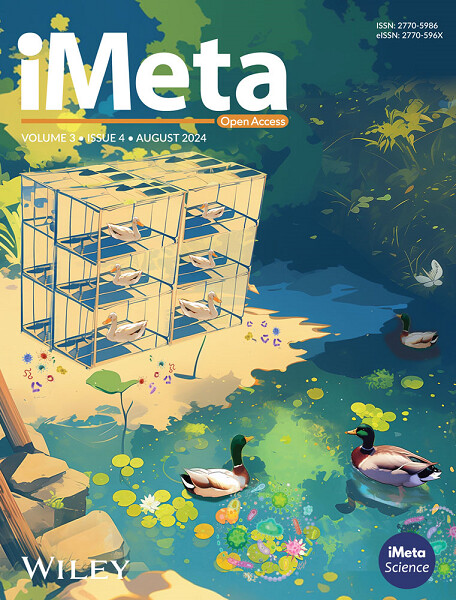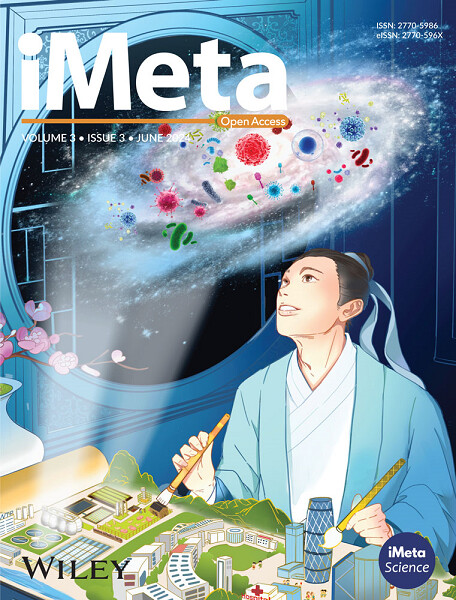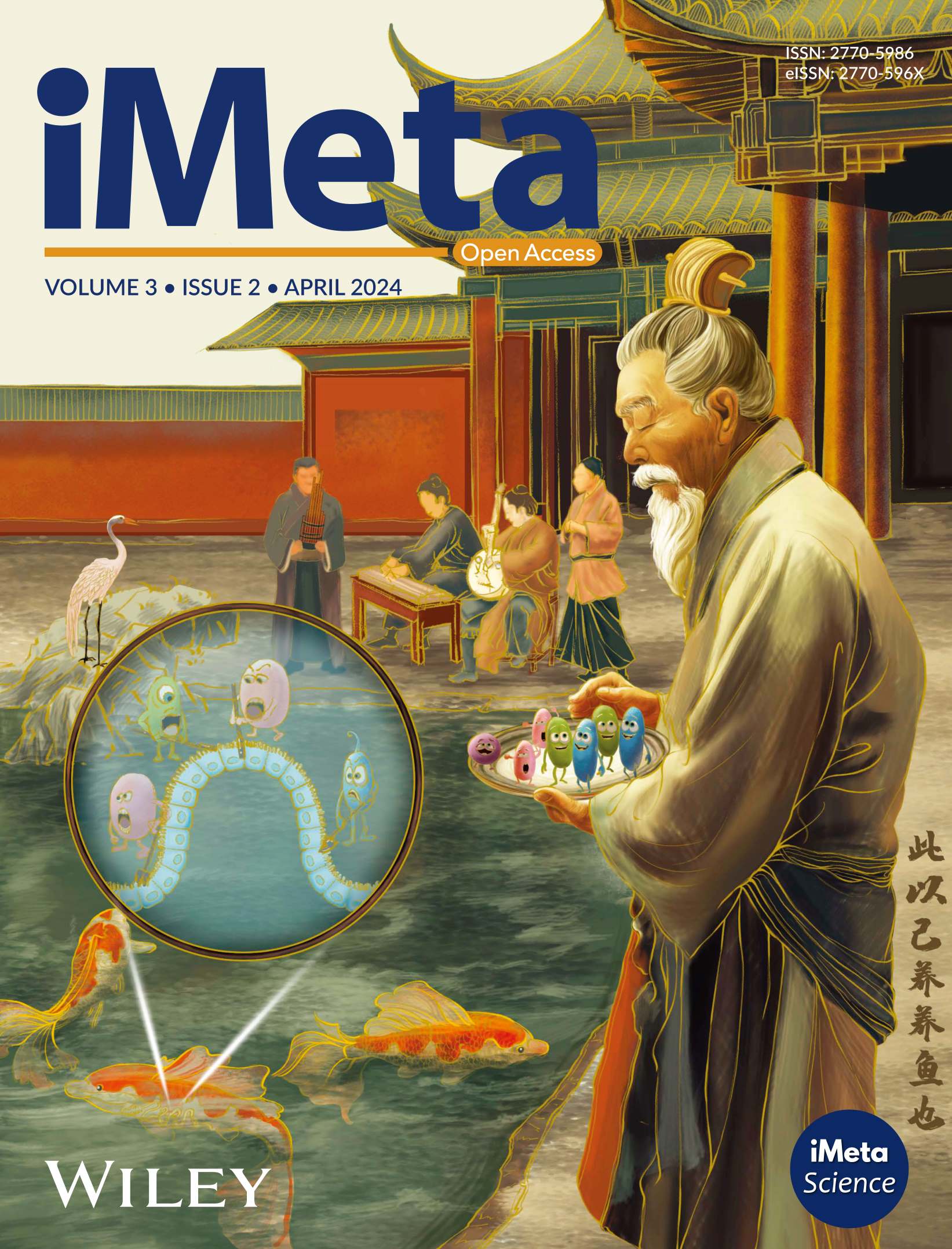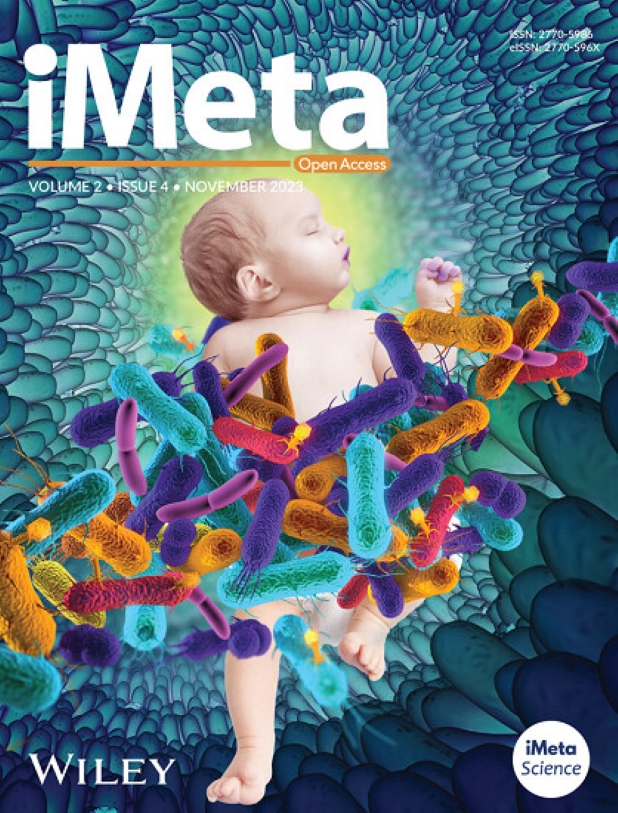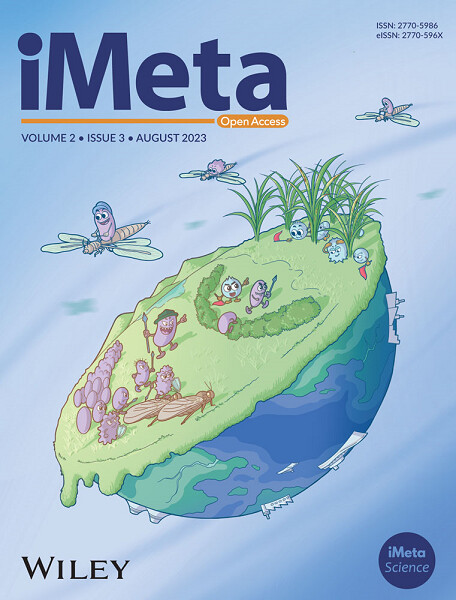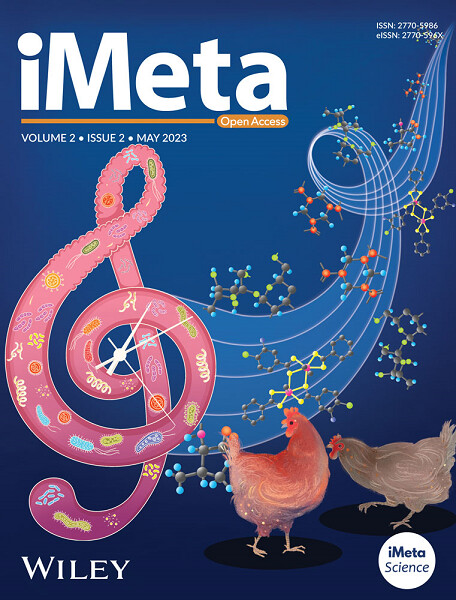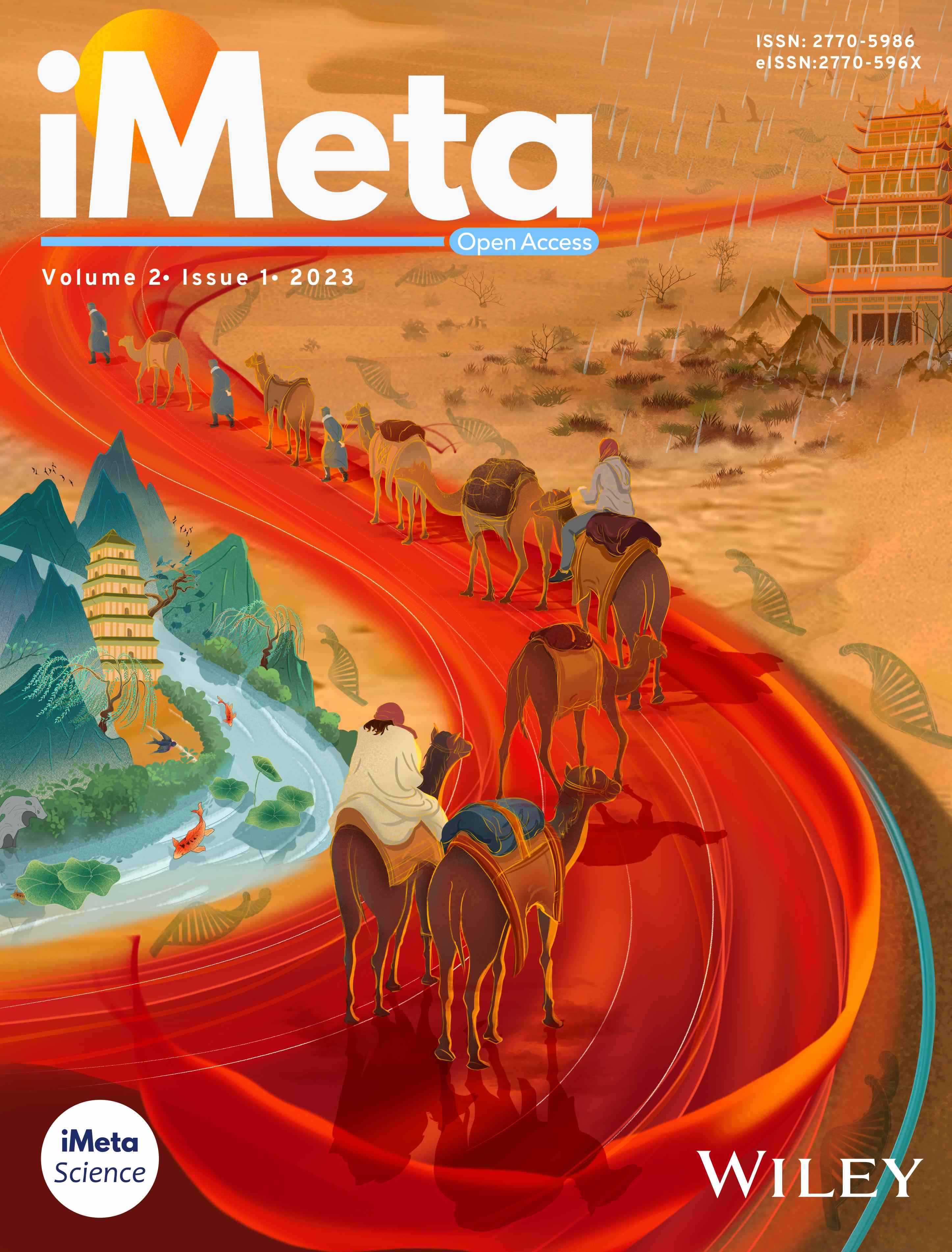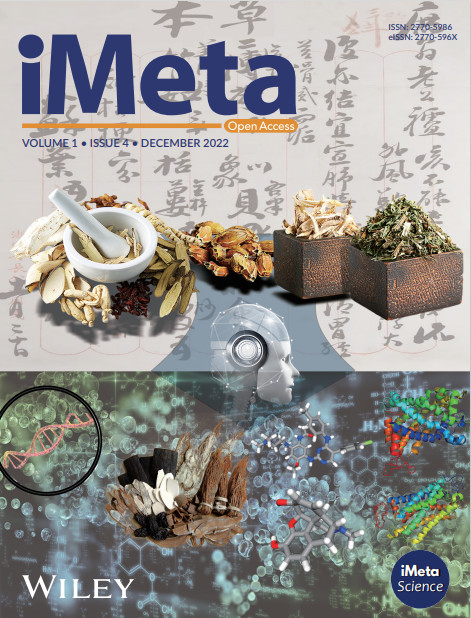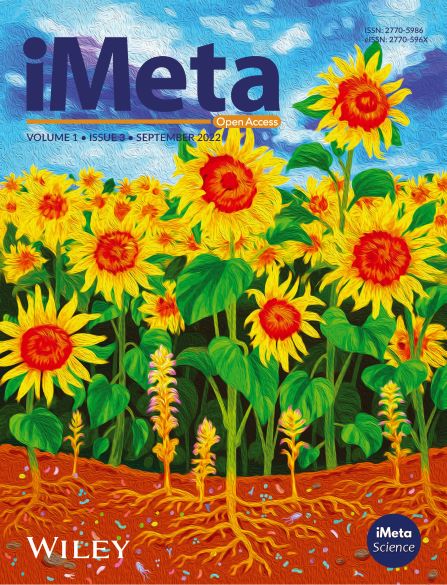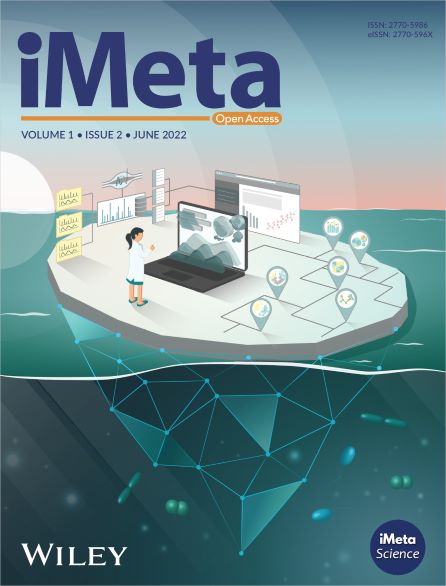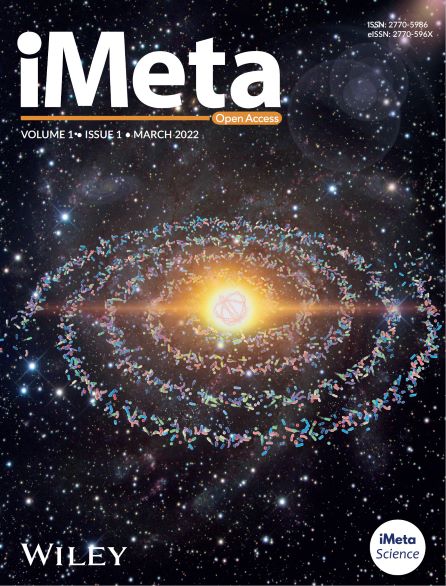Contents
Submission and Peer Review Process
FREE FORMAT SUBMISSION
Manuscripts should be submitted online at https://mc.manuscriptcentral.com/imeta
For help with submissions, please contact: office@imeta.science
This journal does not charge submission fees.
iMeta now offers Free Format submission for a simplified and streamlined submission process.
Before you submit, you will need:
- Your manuscript: this should be an editable file including text, figures, and tables, or figures in separate files—whichever you prefer. All required sections should be contained in your manuscript, including abstract, introduction, methods, results, and conclusions. Figures and tables should have legends. Figures should be uploaded in the highest resolution possible (Figures in vector format is recommended). References may be submitted in any style or format, as long as it is consistent throughout the manuscript. Supporting information should be submitted in separate files. If the manuscript, figures or tables are difficult for you to read, they will also be difficult for the editors and reviewers, and the editorial office will send it back to you for revision. Your manuscript may also be sent back to you for revision if the quality of English language is poor.
- An ORCID ID, freely available at https://orcid.org. (Why is this important? Your article, if accepted and published, will be attached to your ORCID profile. Institutions and funders are increasingly requiring authors to have ORCID IDs.)
- The title page of the manuscript, including:
- Your co-author details, including affiliation and email address. (Why is this important? We need to keep all co-authors informed of the outcome of the peer review process.)
- Statements relating to our ethics and integrity policies, which may include any of the following
(Why are these important? We need to uphold rigorous ethical standards for the research we
consider for publication):
- data availability statement
- funding statement
- conflict of interest disclosure
- ethics approval statement
- patient consent statement
- permission to reproduce material from other sources
- clinical trial registration
To submit, login at https://mc.manuscriptcentral.com/imeta and create a new submission. Follow the submission steps as required and submit the manuscript.
Open Access
Preprint policy:
Please find the Wiley preprint policy here.
This journal accepts articles previously published on preprint servers.
Wiley's Preprints Policy statement for open access journals
[iMeta] will consider for review articles previously available as preprints. You are requested to update any pre-publication versions with a link to the final published article. You may also post the final published version of the article immediately after publication.
Registered Reports
See the Registered Reports Author Guidelines for full details.
Data Sharing and Data Availability
This journal expects data sharing. Review Wiley’s Data Sharing policy where you will be able to see and select the data availability statement that is right for your submission.
Data Citation
Please review Wiley’s Data Citation policy.
Data Protection
By submitting a manuscript to or reviewing for this publication, your name, email address, and affiliation, and other contact details the publication might require, will be used for the regular operations of the publication. Please review Wiley’s Data Protection Policy to learn more.
Funding
You should list all funding sources in the Acknowledgments section. You are responsible for the accuracy of their funder designation. If in doubt, please check the Open Funder Registry for the correct nomenclature.
Authorship
All listed authors should have contributed to the manuscript substantially and have agreed to the final submitted version. Review editorial standards and scroll down for a description of authorship criteria.
ORCID
This journal requires ORCID. Please refer to Wiley’s resources on ORCID.
Reproduction of Copyright Material
If excerpts from copyrighted works owned by third parties are included, credit must be shown in the contribution. It is your responsibility to also obtain written permission for reproduction from the copyright owners. For more information visit Wiley’s Copyright Terms & Conditions FAQ.
The corresponding author is responsible for obtaining written permission to reproduce the material "in print and other media" from the publisher of the original source, and for supplying Wiley with that permission upon submission.
Title Page
The title page should contain:
- A brief informative title containing the major key words. The title should not contain abbreviations (see Wiley's best practice SEO tips);
- A short running title of less than 40 characters;
- The full names of the authors;
- The author's institutional affiliations where the work was conducted, with a footnote for the author’s present address if different from where the work was conducted;
- Corresponding author(s) and email address(es).
Main Text File
The main text file should be in Word or PDF format and include:
Manuscripts can be uploaded either as a single document (containing the main text, tables and figures), or with figures and tables provided as separate files. Should your manuscript reach revision stage, figures and tables must be provided as separate files. The main manuscript file can be submitted in Microsoft Word (.doc or .docx) format.
Your main document file should include:
- A short informative title containing the major key words. The title should not contain abbreviations
- The full names of the authors with institutional affiliations where the work was conducted, with a footnote for the author’s present address if different from where the work was conducted;
- Abstract unstructured
- Up to seven keywords;
- Practitioner Points (optional) Authors will need to provide no more than 3 ‘key points’, written with the practitioner in mind, that summarize the key messages of their paper to be published with their article.
- Main body: formatted as introduction, results, discussion (option in results), conclusion, methods, acknowledgement, author contributions, data and code availability, competing interests
- References;
- Tables (each table complete with title and footnotes);
- Figure legends: Legends should be supplied as a complete list in the text. Figures should be uploaded as separate files (see below).
Reference Style
This journal allows using free reference style; as the journal offers Free Format submission, you do NOT need to format the references in your article before submission.
Figures and Supporting Information
Figures, supporting information, and appendices should be supplied as separate files. All the supplementary tables in one Excel are recommended. You should review the basic figure requirements for manuscripts for peer review, as well as the more detailed post-acceptance figure requirements. View Wiley’s FAQs on supporting information.
Peer Review
This journal operates under a single-blind/double-blind/open/transparent peer review model. Papers will only be sent to review if the Editor-in-Chief determines that the paper meets the appropriate quality and relevance requirements.
If you choose a double-blind peer review, you will need to anonymize your manuscript file and any supplementary material for review and supply a separate title page file.
In-house submissions, i.e. papers authored by Editors or Editorial Board members of the title, will be sent to Editors unaffiliated with the author or institution and monitored carefully to ensure there is no peer review bias.
Wiley's policy on the confidentiality of the review process is available here.
This journal is participating in a pilot on Peer Review Transparency and you have the choice to opt-out during the submission process. By submitting to this journal, you agree that the reviewer reports, their responses, and the editor’s decision letter will be linked from the published article to where they appear on Publons in the case that the article is accepted. Reviewers can choose to remain anonymous unless they would like to sign their report.
Guidelines on Publishing and Research Ethics in Journal Articles
The journal requires that you include in the manuscript details IRB approvals, ethical treatment of human and animal research participants, and gathering of informed consent, as appropriate. You will be expected to declare all conflicts of interest, or none, on submission. Please review Wiley’s policies surrounding human studies, animal studies, clinical trial registration, biosecurity, and research reporting guidelines.
This journal follows the core practices of the Committee on Publication Ethics (COPE) and handles cases of research and publication misconduct accordingly (https://publicationethics.org/core-practices).
This journal uses iThenticate’s CrossCheck software to detect instances of overlapping and similar text in submitted manuscripts. Read Wiley’s Top 10 Publishing Ethics Tips for Authors and Wiley’s Publication Ethics Guidelines.
Author Contributions
For all articles, the journal mandates the CRediT (Contribution Roles Taxonomy)—more information is available on our Author Services site.
Article Preparation Support
Wiley Editing Services offers expert help with English Language Editing, as well as translation, manuscript formatting, figure illustration, figure formatting, and graphical abstract design – so you can submit your manuscript with confidence.
Also, check out our resources for Preparing Your Article for general guidance about writing and preparing your manuscript.
Article Types
iMeta welcomes submissions in the following article types: Research Article, Short Communication, Review Article, Perspective, Method and Protocol, Editorial, Announcement, Commentary and Correspondence.
|
Article Type |
|
Description |
Word Limit |
Abstract / Structure |
Other Requirements |
|
|
|
|
|
|
|
|
Research Article |
|
reports of new research findings or conceptual analyses that make a significant contribution to knowledge |
3000 ~ 6000 words and 4~6 figures. Supplement file is no limit. |
Yes, Structured |
Data and Code Availability IRB Statement
|
|
Short Communication |
|
Brief observations and research reports in a concise format. |
1500 ~ 3000 words and 1~3 figures. |
Yes, Structured |
|
|
Review Article |
|
Overview of developments in fields or the current lines of thought. Synthesizes multiple sources of information and has long list of references. Emphasis is more factual and less on opinion. |
3000 ~ 12000 words, 2~6 figures and tables. |
Yes, unstructured |
|
|
Perspective |
|
Personal opinion on a topic, often with a novel/imaginative approach to a provocative question, with an engaging though rigorous investigation that enhances the understanding of the subject, including new developments, and moderate referencing |
1500 ~ 5000 words |
Yes, unstructured |
|
|
Method and Protocol |
|
Procedural method in the design and implementation of an experiment or study |
3000 ~ 12000 words, figures no limit |
Yes, unstructured |
Troubleshooting |
|
Editorial |
|
To convey an opinion, or overview of an issue, by the Editor or someone invited by the editor |
|
No, unstructured |
|
|
Announcement |
|
Sharing factual information or acknowledgements from the journal or its owners that is not dissemination of knowledge, research, or opinion. |
|
No, unstructured |
|
|
Commentary |
|
Complementary finding or opinion to the current understanding/status of an area, or how practice should be undertaken. Generally with references. |
|
No, unstructured |
|
|
Correspondence |
|
A letter, or response to a letter, sent to the journal to raise a point of interest, discuss a difference of opinion or encourage participation |
|
No, unstructured |
|
After Acceptance
iMeta template download. Please refer to it to format the final manuscript.
iMeta EndNote style download. Use it to format references by EndNote.
First Look
After your paper is accepted, your files will be assessed by the editorial office to ensure they are ready for production. You may be contacted if any updates or final files are required. Otherwise, your paper will be sent to the production team.
Wiley Author Services
When an accepted article is received by Wiley’s production team, the corresponding author will receive an email asking them to login or register with Wiley Author Services. You will be asked to sign a publication license at this point as well as pay for any applicable APCs.
Copyright & Licensing
iMeta is an Open Access journal: authors of accepted papers pay an Article Publication Charge and their papers are published under a Creative Commons license. This journal uses the CC-BY-NC-ND Creative Commons License. Note that certain funders mandate a particular type of CC license be used.
Accepted Articles
The journal offers Wiley’s Accepted Articles service for all manuscripts. Manuscripts accepted ‘in press’ are published online shortly after acceptance, prior to copy-editing or typesetting and appear in PDF format only. After the final version article is published (the article of record), the DOI remains valid and can still be used to cite and access the article.
<Add section for journals indexed on PubMed> Accepted Articles will be indexed by PubMed; submitting authors should carefully check the names and affiliations of all authors provided in the cover page of the manuscript so it is accurate for indexing. The final copyedited and proofed articles will appear in an issue on Wiley Online Library; the link to the article in PubMed will update automatically.
Proofs
Authors will receive an e-mail notification with a link and instructions for accessing HTML page proofs online/with their proofs included as a pdf. Authors should also make sure that any renumbered tables, figures, or references match text citations and that figure legends correspond with text citations and actual figures. Proofs must be returned within 48 hours of receipt of the email.
Article Promotion Support
Wiley Editing Services offers professional video, design, and writing services to create shareable video abstracts, infographics, conference posters, lay summaries, and research news stories for your research – so you can help your research get the attention it deserves.
Author Name Change Policy
In cases where authors wish to change their name following publication, Wiley will update and republish the paper and redeliver the updated metadata to indexing services. Our editorial and production teams will use discretion in recognizing that name changes may be of a sensitive and private nature for various reasons including (but not limited to) alignment with gender identity, or as a result of marriage, divorce, or religious conversion. Accordingly, to protect the author’s privacy, we will not publish a correction notice to the paper, and we will not notify co-authors of the change. Authors should contact the journal’s Editorial Office with their name change request.
Correction to authorship
In accordance with Wiley’s Best Practice Guidelines on Research Integrity and Publishing Ethics and the Committee on Publication Ethics’ guidance, iMeta will allow authors to correct authorship on a submitted, accepted, or published article if a valid reason exists to do so. All authors – including those to be added or removed – must agree to any proposed change. To request a change to the author list, please complete the Request for Changes to a Journal Article Author List Form and contact either the journal’s editorial or production office, depending on the status of the article. Authorship changes will not be considered without a fully completed Author Change form. [Correcting the authorship is different from changing an author’s name; the relevant policy for that can be found in Wiley’s Best Practice Guidelines under “Author name changes after publication.”]
Appendix
Open Research Badges
This journal is part of Wiley’s Open Research Badges program.
Graphical TOC/Abstract
The journal’s table of contents/abstract will be presented in graphical form with a brief abstract.
The table of contents entry must include the article title, the authors' names (with the corresponding author indicated by an asterisk), no more than 80 words or 3 sentences of text summarizing the key findings presented in the paper and a figure that best represents the scope of the paper.
Table of contents entries should be submitted to ScholarOne as ‘Supplementary material for review’ during the initial manuscript submission process.
The image supplied should fit within the dimensions of 50mm x 60mm and be fully legible at this size.
Resource Identification Initiative
The journal supports the Resource Identification Initiative, which aims to promote research resource identification, discovery, and reuse. This initiative, led by the Neuroscience Information Framework and the Oregon Health & Science University Library, provides unique identifiers for antibodies, model organisms, cell lines, and tools including software and databases. These IDs, called Research Resource Identifiers (RRIDs), are machine-readable and can be used to search for all papers where a particular resource was used and to increase access to critical data to help researchers identify suitable reagents and tools.
You will be asked to use RRIDs to cite the resources used in your research where applicable in the text, similar to a regular citation or Genbank Accession number. For antibodies, you should include in the citation the vendor, catalogue number, and RRID both in the text upon first mention in the Methods section. For software tools and databases, please provide the name of the resource followed by the resource website, if available, and the RRID. For model organisms, the RRID alone is sufficient.
Additionally, you must include the RRIDs in the list of keywords associated with the manuscript.
To Obtain Research Resource Identifiers (RRIDs):
- Use the Resource Identification Portal, created by the Resource Identification Initiative Working Group.
- Search for the research resource (please see the section titled “Search Features and Tips” for more information).
- Click on the “Cite This” button to obtain the citation and insert the citation into the manuscript text.
If there is a resource that is not found within the Resource Identification Portal, you are asked to register the resource with the appropriate resource authority. Information on how to do this is provided in the “Resource Citation Guidelines” section of the Portal.
If any difficulties in obtaining identifiers arise, please contact rii-help@scicrunch.org for assistance.
Example Citations:
Antibodies: "Wnt3 was localized using a rabbit polyclonal antibody C64F2 against Wnt3 (Cell Signaling Technology, Cat# 2721S, RRID: AB_2215411)"
Model Organisms: "Experiments were conducted in c. elegans strain SP304 (RRID:CGC_SP304)"
Cell lines: "Experiments were conducted in PC12 CLS cells (CLS Cat# 500311/p701_PC-12, RRID:CVCL_0481)"
Tools, Software, and Databases: "Image analysis was conducted with CellProfiler Image Analysis Software, V2.0 (http://www.cellprofiler.org, RRID:nif-0000-00280)"
Species Names
Upon its first use in the title, abstract, and text, the common name of a species should be followed by the scientific name (genus, species, and authority) in parentheses. For well-known species, however, scientific names may be omitted from article titles. If no common name exists in English, only the scientific name should be used.
Genetic Nomenclature
Sequence variants should be described in the text and tables using both DNA and protein designations whenever appropriate. Sequence variant nomenclature must follow the current HGVS guidelines; see varnomen.hgvs.org, where examples of acceptable nomenclature are provided.
Sequence Data
Nucleotide sequence data can be submitted in electronic form to any of the four major collaborative databases: GSA, DDBJ, EMBL, or GenBank. It is only necessary to submit to one database as data are exchanged between DDBJ, EMBL, and GenBank on a daily basis. The suggested wording for referring to accession-number information is: ‘These sequence data have been submitted to the DDBJ/EMBL/GenBank databases under accession number U12345’. Addresses are as follows:
- Genome Sequence Archive (GSA): https://ngdc.cncb.ac.cn/gsa/
- DNA Data Bank of Japan (DDBJ): ddbj.nig.ac.jp
- EMBL Nucleotide Archive: ac.uk/ena
- GenBank: ncbi.nlm.nih.gov/genbank
Proteins sequence data should be submitted to either of the following repositories:
- Protein Information Resource (PIR): georgetown.edu
- SWISS-PROT: ch/sprot/sprot-top
Structural Data
For papers describing structural data, atomic coordinates and the associated experimental data should be deposited in the appropriate databank (see below). Please note that the data in databanks must be released, at the latest, upon publication of the article. We trust in the cooperation of our authors to ensure that atomic coordinates and experimental data are released on time.
- Organic and organometallic compounds: Crystallographic data should not be sent as Supporting Information, but should be deposited with the Cambridge Crystallographic Data Centre (CCDC) at cam.ac.uk/services/structure%5Fdeposit.
- Inorganic compounds: Fachinformationszentrum Karlsruhe (FIZ; fiz-karlsruhe.de).
- Proteins and nucleic acids: Protein Data Bank (org/pdb).
- NMR spectroscopy data: BioMagResBank (wisc.edu).
Cover Image Submissions
This journal accepts artwork submissions for Cover Images. This is an optional service you can use to help increase article exposure and showcase your research. For more information, including artwork guidelines, pricing, and submission details, please visit the Journal Cover Image page.
Wiley Editing Services offers a professional cover image design service that creates eye-catching images, ready to be showcased on the journal cover.
Additional Guidelines for Cover Pictures, Visual Abstracts, Frontispieces and Table of Contents Graphics
- Concepts illustrated in graphical material must clearly fit with the research discussed in the accompanying text.
- Images featuring depictions or representations of people must not contain any form of objectification, sexualization, stereotyping, or discrimination. We also ask authors to consider community diversity in images containing multiple depictions or representations of people.
- Inappropriate use, representation, or depiction of religious figures or imagery, and iconography should be avoided.
- Use of elements of mythology, legends, and folklore might be acceptable and will be decided on a case-by-case basis. However, these images must comply with the guidelines on human participants when they are present.
- Generally, authors should consider any sensitivities when using images of objects that might have cultural significance or may be inappropriate in the context (for example, religious texts, historical events, and depictions of people).
- Legal requirements:
- All necessary copyright permission for the reproduction of the graphical elements used in visuals must be obtained prior to publication.
- Clearance must be obtained from identifiable people before using their image on the cover or the like and such clearance must specify that it will be used on the cover. Use within text does not require such clearance unless it discloses sensitive personal information such as medical information. In all situations involving disclosure of such personal info, specific permission must be obtained. And images of individuals should not be used in a false manner.
Graphics that do not adhere to these guidelines will be recommended for revision or will not be accepted for publication.
Embedded Rich Media
This journal has the option for authors to embed rich media (i.e. video and audio) within their final article. These files should be submitted with the manuscript files online, using either the “Embedded Video” or “Embedded Audio” file designation. If the video/audio includes dialogue, a transcript should be included as a separate file. The combined manuscript files, including video, audio, tables, figures, and text must not exceed 350 MB. For full guidance on accepted file types and resolution please see here.
Ensure each file is numbered (e.g. Video 1, Video 2, etc.) Legends for the rich media files should be placed at the end of the article.
The content of the video should not display overt product advertising. Educational presentations are encouraged.
Any narration should be in English, if possible. A typed transcript of any speech within the video/audio should be provided. An English translation of any non-English speech should be provided in the transcript.
All embedded rich media will be subject to peer review. Editors reserve the right to request edits to rich media files as a condition of acceptance. Contributors are asked to be succinct, and the Editors reserve the right to require shorter video/audio duration. The video/audio should be high quality (both in content and visibility/audibility). The video/audio should make a specific point; particularly, it should demonstrate the features described in the text of the manuscript.
Participant Consent: It is the responsibility of the corresponding author to seek informed consent from any identifiable participant in the rich media files. Masking a participant’s eyes, or excluded head and shoulders is not sufficient. Please ensure that a consent form (https://authorservices.wiley.com/author-resources/Journal-Authors/licensing/licensing-info-faqs.html) is provided for each participant.
Author presentation video
Video submission: 3~10 min speech video to introduce your work with submission. You can also introduce yourself. Try your best to convince editors and reviewers.




